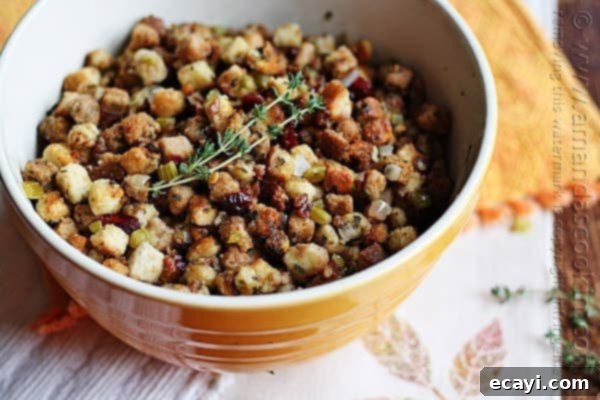Ultimate Herb and Cranberry Pecan Stuffing: Your Essential Holiday Side Dish
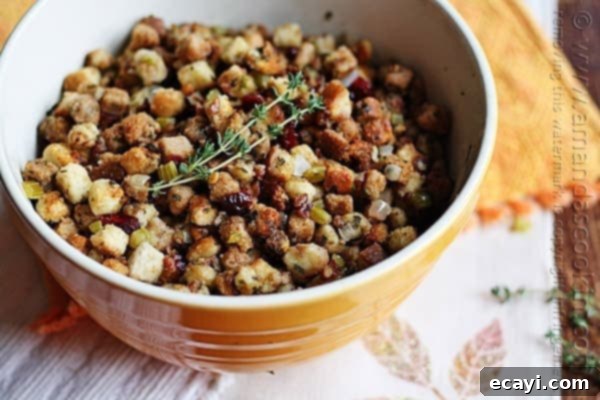
For many, the holiday season, especially Thanksgiving, feels incomplete without the comforting presence of a delicious stuffing. It’s more than just a side dish; it’s a cherished tradition, a centerpiece that brings warmth and flavor to the festive table. Each year, my own Thanksgiving celebration begins with a beautiful, fresh turkey, sourced from my wonderful neighbor who runs a dairy farm. Preparing this magnificent bird is a ritual, starting with a careful brine that ensures a succulent roast to perfection. But before it enters the oven, it must be filled with a flavorful stuffing, and the remaining dressing is always lovingly piled into a baking dish, ready to be heated and enjoyed by all.
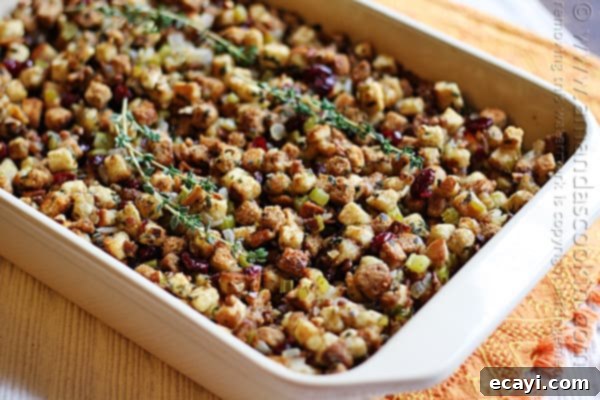
The versatility of stuffing truly shines during the holidays. A couple of years ago, Pepperidge Farm challenged me to innovate with their herb-seasoned stuffing, leading to the creation of this delightful Herbed Breakfast Stuffing Casserole. It’s an absolute hit, perfect not just for Thanksgiving dinner but also for a festive Christmas morning breakfast. This year, they presented a new and exciting opportunity: developing a recipe using their unseasoned stuffing. This product is a dream for home cooks, providing a blank canvas for your culinary imagination and allowing you to craft a stuffing recipe that’s truly your own, tailored to your family’s tastes. It’s an invitation to experiment with flavors and textures, making your holiday meal uniquely special. *Psst… don’t forget to check out the special giveaway details at the end of this post for your chance to try this fantastic unseasoned stuffing yourself!*
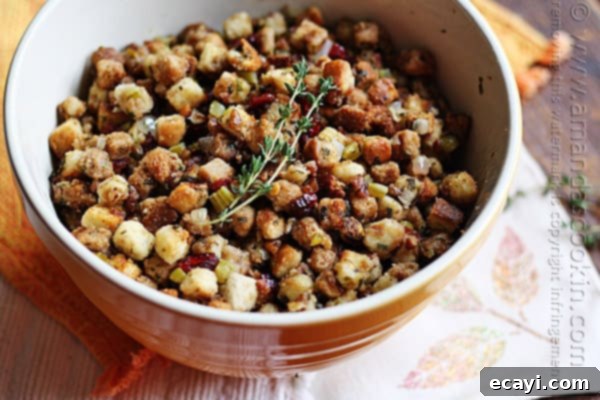
You might find it a little whimsical to connect a Simon & Garfunkel song to a Thanksgiving stuffing recipe, but hear me out! Every time I reach for that quartet of classic herbs on my spice rack—parsley, sage, rosemary, and thyme—I can’t help but hum the tune. These four herbs are culinary magic, each boasting a distinct yet complementary flavor profile. Parsley offers a fresh, clean note; sage brings an earthy, savory warmth; rosemary adds a woody, aromatic depth; and thyme contributes a subtle, peppery undertone. Together, they create a harmonious blend that is utterly essential for a truly traditional and deeply flavorful stuffing. Incorporating them into this recipe wasn’t just a choice; it was a must. To elevate the stuffing further and introduce layers of sweet and nutty notes, I also added a generous amount of pomegranate-flavored dried cranberries and perfectly chopped pecans. The cranberries provide a delightful tang and chewiness, while the pecans offer a satisfying crunch and rich, buttery flavor, making every bite a delightful experience.
Crafting Your Perfect Herb and Cranberry Pecan Stuffing: A Step-by-Step Guide
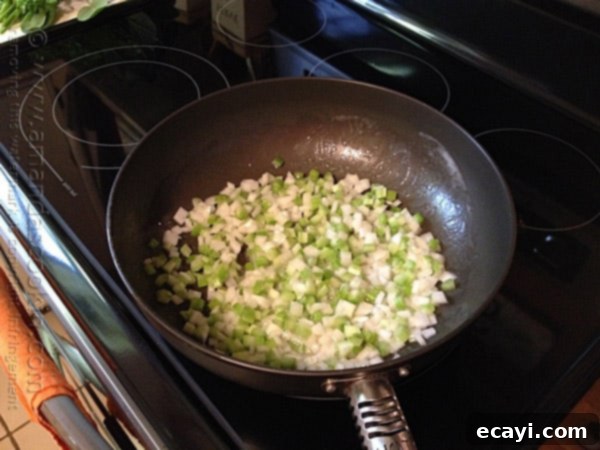
The journey to the perfect stuffing begins with a foundation of aromatics. In a large, sturdy skillet, melt the unsalted butter over medium heat. Once melted and shimmering, add your finely chopped onion and celery. Sauté these vegetables for approximately 5 minutes, or until they begin to soften and become translucent. This step is crucial as it coaxes out their natural sweetness and creates a fragrant base for the entire dish. Next, stir in your fresh herbs: the aromatic sage, the delicate sprigs of thyme, vibrant parsley, and fragrant rosemary. As they heat, these herbs will release their essential oils, infusing the butter and vegetables with their incredible aromas. If the mixture appears a little dry at this stage, a teaspoon of olive oil can be added to ensure everything is nicely coated and continues to sauté smoothly without sticking.
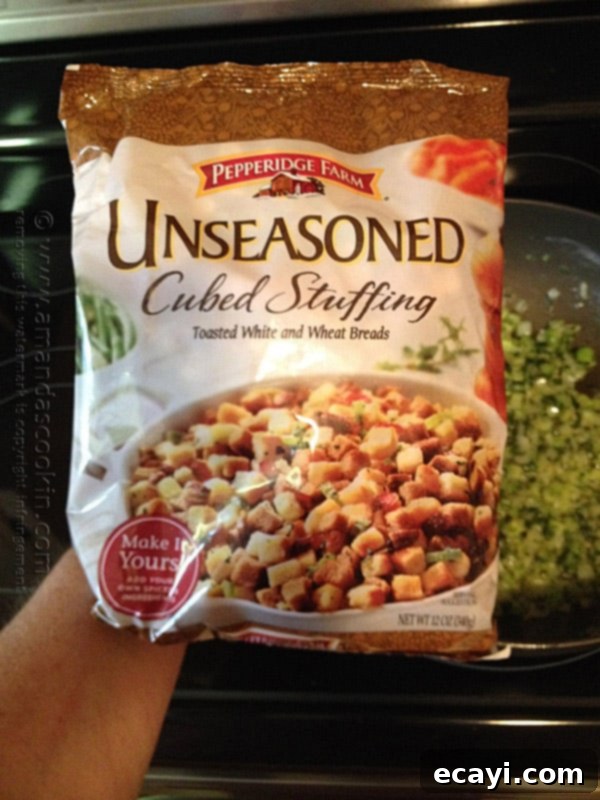
Now, it’s time for the star of the show: the Pepperidge Farm unseasoned cubed stuffing. This product is a fantastic shortcut, providing perfectly cut bread cubes that are ready to absorb all the delicious flavors you’ve built. Carefully pour the entire bag of stuffing cubes directly into the skillet with your sautéed vegetables and herbs. The unseasoned nature of these cubes means you have complete control over the final flavor profile, allowing your chosen herbs and seasonings to truly shine. This is where the customization aspect truly comes into play, enabling you to make this stuffing uniquely yours.
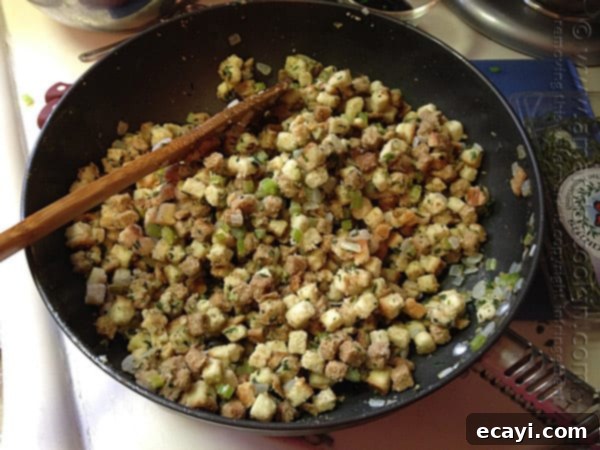
With all the components in the skillet, gently toss everything together until the stuffing cubes are evenly mixed with the fragrant vegetables and herbs. The goal here is to distribute the flavors thoroughly. Then, gradually add the chicken broth. Begin with 1 ½ cups of chicken broth, pouring it slowly over the stuffing mixture. Carefully toss again, ensuring that as many of the stuffing cubes as possible are moistened. The broth is essential for softening the bread and binding all the ingredients together, creating that classic moist and tender stuffing texture. Don’t rush this step; gentle tossing helps ensure even absorption without breaking down the bread cubes too much.
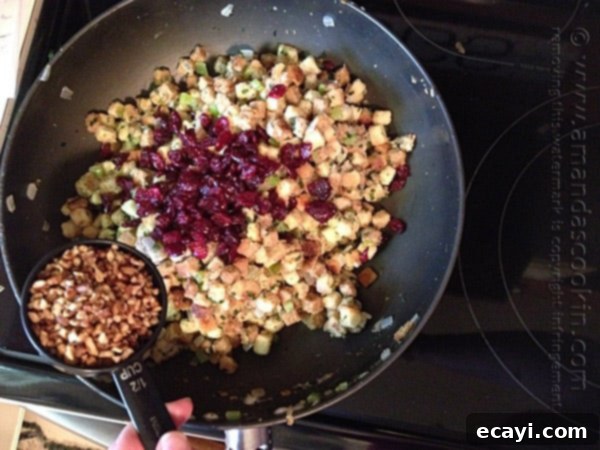
Once the initial broth has been absorbed, add the dried cranberries and chopped pecans to the skillet. These additions not only introduce wonderful texture and flavor contrasts—sweet, tart, and nutty—but also make the stuffing feel truly celebratory. Give it another gentle toss to incorporate them. Now, it’s time to fine-tune the moisture content. Bit by bit, add the remaining chicken broth, continuing to toss gently. The key is to add just enough broth until the mixture begins to bind together, becoming moist and cohesive, but without becoming soggy. You might not need all of the remaining broth, so trust your judgment and the texture of the stuffing. Season with salt and freshly ground black pepper to taste, adjusting as needed to enhance all the wonderful flavors you’ve built.
Stuffing Your Bird or Baking Separately: Your Choice!
At this point, your stuffing is ready for its final destination. If you’re planning to stuff a turkey, now is the time to do so. Gently and loosely pack some of the prepared stuffing into the bird’s cavity. Remember, it’s crucial not to pack it too tightly, as the stuffing expands during cooking, and a loose pack allows for even heat distribution and ensures food safety. Over-packed stuffing can lead to uneven cooking and potentially dangerous temperatures. For optimal safety, ensure the stuffing reaches an internal temperature of 165°F (74°C).
For the remaining mixture, or if you prefer to bake all your stuffing outside the bird, transfer it into a baking pan. A 13×9 inch baking dish is ideal if you’re not stuffing the turkey, providing a nice surface area for crispiness. If you have stuffed the bird, a smaller 9×9 inch pan will be sufficient for the excess. Cover the pan securely with aluminum foil and bake it in a preheated oven at 350°F (175°C) for 20 minutes. The foil helps to steam the stuffing, keeping it moist and tender. After 20 minutes, remove the foil and continue baking for another 10-15 minutes. This final uncovered baking time allows the top layer of the stuffing to become beautifully golden brown and delightfully crispy, adding another layer of texture that everyone loves.
Full printable instructions for this delicious recipe are provided below!
Holiday Stuffing Tips & Variations: Elevate Your Dish
Creating the perfect holiday stuffing is an art, and with this versatile recipe, you have a fantastic foundation to build upon. Here are some tips and variations to help you customize your stuffing and make it truly unforgettable:
- Broth Options: While chicken broth is classic, feel free to experiment with vegetable broth for a vegetarian option, or turkey broth (especially if you’ve made your own from turkey giblets) for an even richer, more profound turkey flavor.
- Add a Savory Kick: For a heartier stuffing, consider browning 1/2 to 1 pound of breakfast sausage or Italian sausage (mild or hot, depending on your preference) and crumbling it into the mixture after draining any excess fat.
- Fruity Additions: Beyond pomegranate cranberries, dried apricots, regular dried cranberries, or golden raisins can add different dimensions of sweetness and chewiness. Fresh chopped apples (like Granny Smith for tartness or Fuji for sweetness) also work wonderfully, adding moisture and a crisp-tender texture.
- Earthy Notes: Sautéed mushrooms (cremini or shiitake work well) can lend a deep, umami flavor. Toasted chestnuts, a traditional stuffing ingredient, also add a delightful earthy sweetness and soft texture.
- Nutty Flavors: If pecans aren’t your favorite, walnuts or even a mix of nuts can be used. Toasting the nuts lightly before adding them can enhance their flavor significantly.
- Herbs: While parsley, sage, rosemary, and thyme are a classic blend, you can adjust quantities based on your preference. A touch of marjoram or a pinch of poultry seasoning can also be lovely additions. For convenience, you can use dried herbs, but remember that dried herbs are more potent, so use about half the amount of fresh herbs.
- Make-Ahead Instructions: To save time on the big day, you can prepare the stuffing mixture (combining all ingredients except the final broth additions and baking) a day in advance. Store it covered in the refrigerator. On cooking day, bring it to room temperature, add the remaining broth if needed, and proceed with baking.
- Achieving Crispy Top: If you love a super crispy top, after removing the foil, you can drizzle a little extra melted butter over the top before the final baking stage. You can also broil it for the last 1-2 minutes, watching carefully to prevent burning.
- Avoiding Soggy Stuffing: The most common stuffing pitfall is sogginess. The key is to add broth gradually and stop when the mixture is moist but not swimming in liquid. The bread cubes should be soft but still hold their shape.
- Storage and Reheating: Leftover stuffing can be stored in an airtight container in the refrigerator for up to 3-4 days. To reheat, cover with foil and warm in a 300°F (150°C) oven until heated through, or microwave individual portions. For a crispy texture, uncover during the last few minutes of reheating in the oven.
This recipe, centered around the quality and convenience of Pepperidge Farm’s unseasoned stuffing, invites you to be creative and make a holiday dish that perfectly suits your family’s palate. Happy cooking!
How do you make your holiday stuffing?
We’d love to hear your unique stuffing traditions and recipe suggestions! Share your ideas in the comments below for a chance to win samples of the new Pepperidge Farm Unseasoned Stuffing! We’ll be selecting two lucky winners. Please make sure to enter by November 30, 2013, and ensure you have a valid U.S. shipping address to receive your prize.
Disclosure: Pepperidge Farm generously compensated me for the time and effort I invested in creating this delicious recipe and sharing this blog post with all of you. My sincere thanks go out to Pepperidge Farm for this wonderful opportunity and to each of you for taking the time to read along and be a part of our culinary community!
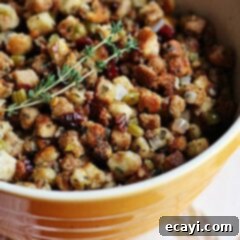
Stuffing with Parsley, Sage, Rosemary and Thyme
IMPORTANT – There are often Frequently Asked Questions within the blog post that you may find helpful. Simply scroll back up to read them!
Print It
Pin It
Rate It
Save ItSaved!
Ingredients
- 4 tablespoons unsalted butter
- 1 cup chopped onion
- 1 cup chopped celery
- 2 tablespoons fresh sage
- 2 sprigs fresh thyme
- ½ cup fresh parsley
- 1 teaspoon fresh rosemary
- 1 teaspoon olive oil if needed
- 1 bag Pepperidge Farm Unseasoned Cubed Stuffing
- ½ cup Pomegranate Craisins
- ½ cup chopped pecans
- 2 – 2 ½ cups chicken broth
- Salt and pepper to taste
Instructions
-
First melt the butter in a large skillet, then add the onion and celery. Saute for about 5 minutes, until it begins to soften. Add in the herbs, and if the mixtures feels a bit dry, add in the olive oil as well.
-
Next, add in the Pepperidge Farm unseasoned cube stuffing. Pour the whole bag into the skillet.
-
Carefully toss it all together. Add in 1 1/2 (one and a half) cups of the chicken broth and carefully toss to coat as much as you can.
-
Add in the dried cranberries and the pecans and toss. Bit by bit, add the remaining broth until it begins to bind but does not get soggy. You may or may not use it all. At this point you can season with salt and pepper if you desire.
-
If you like to stuff your bird, go ahead and use some of the stuffing to loosely pack the bird’s cavity. Don’t pack it too tight!
-
Put the remaining mixture into a baking pan (use a 13×9 if not stuffing the bird, or a 9×9 if you are) and bake it, covered with foil, at 350 F for 20 minutes. Remove the foil and bake another 10-15 minutes if you like the top to be a bit crispy.
The recipes on this blog are tested with a conventional gas oven and gas stovetop. It’s important to note that some ovens, especially as they age, can cook and bake inconsistently. Using an inexpensive oven thermometer can assure you that your oven is truly heating to the proper temperature. If you use a toaster oven or countertop oven, please keep in mind that they may not distribute heat the same as a conventional full sized oven and you may need to adjust your cooking/baking times. In the case of recipes made with a pressure cooker, air fryer, slow cooker, or other appliance, a link to the appliances we use is listed within each respective recipe. For baking recipes where measurements are given by weight, please note that results may not be the same if cups are used instead, and we can’t guarantee success with that method.
